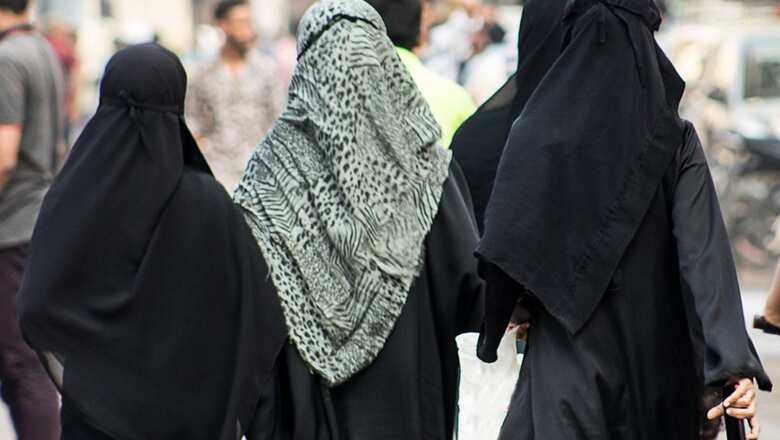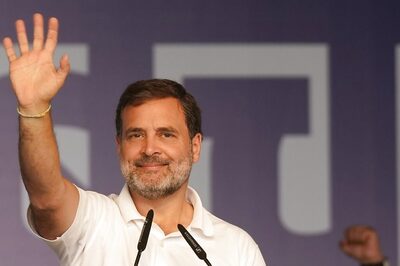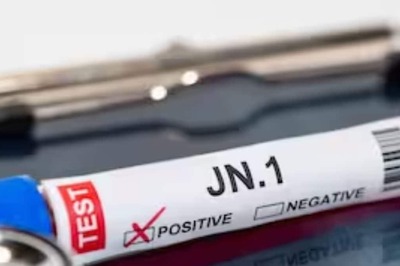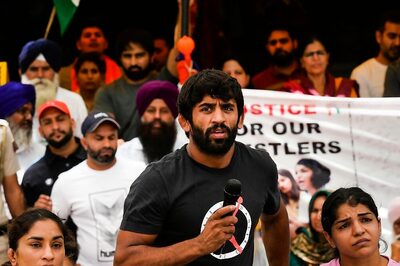
views
Smriti Irani, the Union Minister of Minority Affairs, led the first-ever non-Muslim Indian delegation to Madinah, one of the holiest cities in Islam, on January 8, 2024. She visited the periphery of the Prophet’s Mosque, the mountain of Uhud, and the Quba Mosque. She also interacted with Indian volunteers serving Haj and Umrah pilgrims.
This was a historic and rare diplomatic gesture by Saudi Arabia, which reflects the deep cultural and spiritual engagement the two countries are developing. It also came after Irani signed the Bilateral Haj Agreement 2024 with Saudi Arabia, securing a quota of 175,025 pilgrims for India.
Abhijit Majumder, journalist and consulting editor of Firstpost, wrote an article ‘Gaza to Smriti: Islam at war with itself as Arabs reform, neo-convert Muslims regress’. He is optimistic that ‘as the richer and more influential part of the Islamic world reforms, the excitable hinterland of relatively newer converts is bound to follow’. My take is that the hinterlands are not even aware of these reforms or Mohammad bin Salman or Sheikh Zayed. The male Muslim mind individually and collectively works to keep not just the female folk in darkness and conditioned to a dhimmi state but the male population too.
The Muslim elite of the hinterland has created an ecosystem that sustains victimhood (Oppression Olympics), boosts the blame game or scapegoating of Hindutva for the community’s backwardness and ills, and has created a totalitarian system in academia and media wherein dissenters, heretics, and agnostics from Muslim heritage are cancelled out, not given space, or outrightly threatened. Take any hinterland Muslim ghetto, Muslim qasba (district), or Muslim-majority enclave, town, village, or tehsil. They have either never heard of the Arab Spring or what reforms the richer, influential Islamic world is undertaking.
While the left-liberal jamaat and Muslim far right accuses the Hindu right wing of pushing WhatsApp forwards or groups, scores of Hamas, ISIS, and Pakistani propaganda videos, memes, and links have found a consumer base among the 20 crore Muslims of India. Be it the CAA/NRC, Article 370, banning triple talaq, the hijab debate, UCC, or the cultural resurgence of India, the Muslim elite and their minions in lakhs make sure the entire community is thinking on the same lines and voting en masse.
At least they try to, but the Internet cuts both ways. The reforms that Abhijit Majumder talks about in his article, have yet to make an impact on the hinterland Muslim mind, not to mention my scepticism of MbS being a reformist and secularist, considering Raif Badawi — Saudi’s most famous dissident — had to face lashes and imprisonment. Reforms happening in the rich, influential part of the Islamic world don’t get much traction in the Muslim-majority pockets of the birthplace of the idea of Pakistan, i.e., Uttar Pradesh, especially Aligarh Muslim University.
The clergy class has started the demonisation of these reforms and reformers by embellishing and disseminating the ‘dajjal concept’ in Islamic theology — a false messiah who will appear before the end of time and claim to be God. The Muslim clergy, disconnected from the common Muslims, and the Muslim intelligentsia hell-bent on holding onto power, are pontificating to the Muslim masses that these times of the Hindu cultural resurgence are the end of times and that any reformer, be it MbS, or the subcontinental activists who are struggling for UCC; the subcontinental activists are the false messiahs.
Anything to keep the 20 crores in perpetual darkness, conditioned, and in victimhood for the vote bank politics, power, and the usual chessboard of politics. Islam’s ‘poor catchment areas’, as Abhijit Majumder describes them aptly in his article, the Indian subcontinent, sub-Saharan Africa and their diaspora, have to first deal with the regressive left from Hindu heritage, or the ‘useful idiotic’ Islamophiles who whitewashed the subcontinent’s history and the brutal Islamic conquests out of Arabia, on Persians, Europeans, and Hind.
They also have to deal with the ‘Woke Army’: the Red-Green Alliance, as the fiery Asra Nomani calls them in her journalistic investigation of a network of radical Islamist and leftist activists who use online trolling, disinformation, and intimidation to silence critics, all the time, undermining India’s territorial integrity and sovereignty.
The 20 crore Indian Muslims are not all on social media; hence they are assimilated and integrated into the ethos of Indic civilisation. Be it the Hindu rituals incorporated by the Muslim Rajputs into their customs, or Tamil sub-groups visiting Hindu gurus, maths, and monks; a towering example being the 11th President of India, our Missile Man, APJ Abdul Kalam. The takfiri-ism he was subjected to (the practice of cancelling out those who are not Muslim enough according to the gatekeepers of morality) is enough to silence us mere mortals who are gingerly trying to get justice for the travesties that Muslim Personal Law (Sharia) has done to us, especially Muslim women.
Leading this ‘takiri-ism’ and the subcontinental ‘woke army’ are journos, reporters, columnists, authors, panellists, and academicians with tenure, embedded in the media and educational institutions. I coined the term ‘Nivi Ma’am’s charges’ from the character in The Kashmir Files, played brilliantly by Pallavi Joshi. It is a test of the mind, poise, grace, and rationality to debate that the Pulwama suicide bombing was not an inside job by the government with Nivi Ma’am’s charges. If one sits and lists out the ways Sharia laws violate the rights of Muslim women, be it inheritance rights, marriage and divorce rights, child custody and adoption rights, there’s a blank stare, as the wheels of their minds start scrolling through Nivi Ma’am’s lectures, because the data doesn’t fit the ‘Muslim genocide’ narrative.
The idea, that even if one woman in the world is coerced into mandatory veiling, the way it is happening in Afghanistan under the Taliban and Iran’s women’s resistance in the wake of Masha Amini’s custodial murder, the hijab can never be a “choice” is foreign to the woke. That there are regressive practices in Islamic culture like female genital mutilation (FGM), mutah and halala marriages, honour killings abandoning of women and children under triple talaq, elicits the customary shocked response before it is back to Nivi Ma’am’s talking points.
And these are educated youth, from prestigious universities in the national capital, who believe they know what the Indian nation-state should stand for. Almost all of them have been to therapy and are taking anti-depressant medicines, making me proud of my generation which suffers from PTSD from grenade/IED blast and cross-firing experiences, having seen body parts, spilled intestines on the streets of Srinagar in the 1990s and yet not relying on pseudoscience while bringing up emotionally sound and stable children.
In a recent podcast with Mark Manson, author of the best-selling The Subtle Art of Not Giving a F*ck, David Brooks, an American journalist known for his conservative political and cultural views, discussed “conflict entrepreneurs”. To us Kashmiris, it took a good part of three decades to understand the term and ecosystem that Brooks outlined in the podcast. One can easily apply Brooks’s observations to the Indian youth who are socially isolated, given the breakdown of the traditional family structure and urban migration; hence they pick up politics as a means to compensate for their ‘diminished happiness’.
According to Brooks, this is a very bad idea for curing loneliness because the polarised thinking portrays one side as evil and the other as good, exaggerating the potential catastrophes to fuel fear and anger. This makes them ‘conflict entrepreneurs’ and this identification with over politicisation of public issues and those of national security in addition to the funding provided by anti-India forces (‘Snakes in the Ganga and Jhelum’ type) makes a bad mix. Throw in the left-liberal jamaat and the Islamists and you get Shaheen Baghs, chicken-neck politics, rage in Kashmir, the settler-colonial narrative, and conspiracy theories like the Pulwama suicide bombing was an inside job.
I felt the need to extend Abhijit Majumder’s arguments in the article, faced with the reality of ‘Muslim areas’ I have been touring in the hinterland. The rhetoric of the 1930s and 40s is very much in the Muslim mind, “sufficiently imagining” mini Pakistans within India even today. The evidence keeps pouring forth in the rhetoric of the Muslim politicians and the punks bragging on reels on social media, and the “eminent” journos writing for left-leaning media houses.
The Muslim women voting for the BJP, or the Muslim women part of the consecration ceremony at Ayodhya, the one Rajput Muslim professor from Aligarh running a think tank devoted to the Prime Minister or J&K Police officers dying in the line of fire in counter-terror operations, the scores of cultural Muslims, progressive, atheist, agnostic, heretic, dissenting, and lapsed ones, whose testimonies I have collected over the years point to the optimistic reform among the ‘relatively new converts’ that Abhijit Majumder refers to.
Pragmatically, realistically it will take a few more decades before this progress and reform are mainstream in the Indian subcontinent.
The author is a writer and an educationist from Srinagar. Views expressed in the above piece are personal and solely those of the author. They do not necessarily reflect News18’s views




















Comments
0 comment